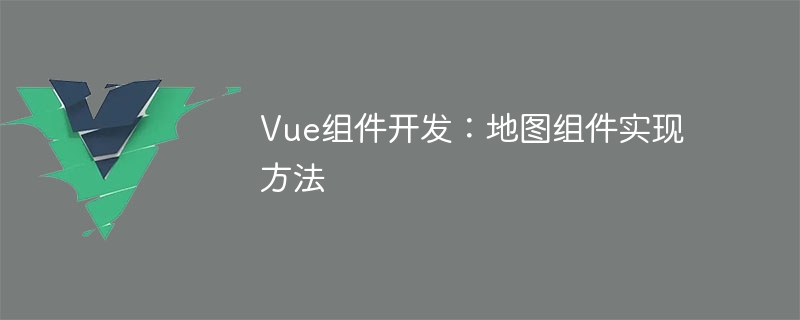

Vue component development: map component implementation method, specific code examples are required
1. Introduction
With the continuous development of the Internet, map applications are used in various industries applications are gradually increasing. The map component is a common component, mainly used to display geographical location information in Web pages or implement map interactive functions. This article will introduce how to use the Vue framework to develop a map component and give specific code examples.
2. Technology Selection
Before developing the map component, you need to choose a suitable map library. Commonly used map libraries include Baidu Maps, Amap, Google Maps, etc. In this article, we choose to use Baidu Maps as an example because Baidu Maps provides rich API and good documentation support.
3. Component design
public/index.html file: <script src="https://api.map.baidu.com/api?v=3.0&ak=your_ak"></script>
where your_ak needs to be replaced with your own Baidu Map API password key.
<div> tag, as shown below: <template> <div id="map-container"></div> </template>
created life In the cycle hook, initialize the map. Map instances can be created using the BMap.Map class provided by Baidu Maps. When creating a map instance, you need to specify the id of the map container and the initial coordinates of the map center point. The specific code is as follows: <template>
<div id="map-container"></div>
</template>
<script>
export default {
created() {
// 初始化地图
const map = new BMap.Map("map-container");
const point = new BMap.Point(116.404, 39.915); // 设置地图中心点坐标
map.centerAndZoom(point, 15); // 设置地图级别
}
}
</script>4. Map component encapsulation
Encapsulate the above basic functions into a reusable Vue component. First, add the corresponding code for the map container and map initialization in the component, and then pass the center point coordinates and level of the map through props. The final code is as follows:
<template>
<div id="map-container"></div>
</template>
<script>
export default {
props: {
center: { type: Object, required: true }, // 地图中心点坐标
zoom: { type: Number, default: 12 } // 地图级别,默认为12
},
created() {
// 初始化地图
const map = new BMap.Map("map-container");
const point = new BMap.Point(this.center.longitude, this.center.latitude);
map.centerAndZoom(point, this.zoom);
}
}
</script>5. Using the map component
The method of using the map component in the Vue project is as follows.
First, import the map component and register it. Add the following code to the page where you need to use the map:
<template>
<div>
<map-component :center="mapCenter"></map-component>
</div>
</template>
<script>
import MapComponent from "@/components/MapComponent.vue";
export default {
components: {
MapComponent
},
data() {
return {
mapCenter: { // 地图中心点坐标
longitude: 116.404,
latitude: 39.915
}
};
}
}
</script>where mapCenter is an object representing the coordinates of the center point of the map. .
6. Summary
This article introduces how to use the Vue framework to develop a map component and gives specific code examples. By encapsulating map components, map display and interactive functions can be quickly implemented in Vue projects. Of course, the above example is just a simple demonstration, and more map-related functions and styles may need to be added in actual projects. We hope that readers can master the development methods of map components through the introduction of this article and bring better experience and effects to your projects.
The above is the detailed content of Vue component development: map component implementation method. For more information, please follow other related articles on the PHP Chinese website!
 How to make charts and data analysis charts in PPT
How to make charts and data analysis charts in PPT
 Android voice playback function implementation method
Android voice playback function implementation method
 AC contactor use
AC contactor use
 The difference between vscode and visual studio
The difference between vscode and visual studio
 The difference between Java and Java
The difference between Java and Java
 Introduction to hard disk interface types
Introduction to hard disk interface types
 nagios configuration method
nagios configuration method
 How to delete a folder in linux
How to delete a folder in linux




